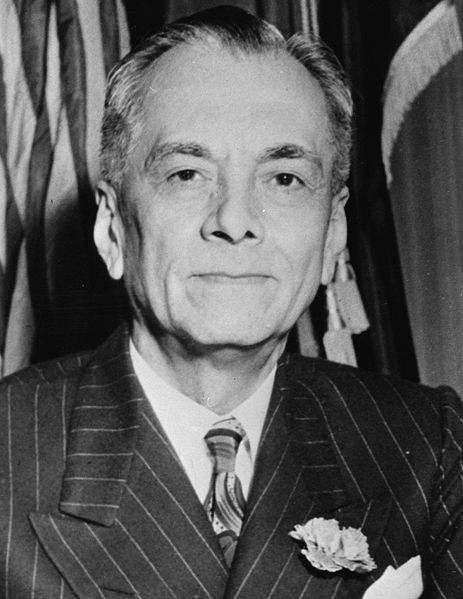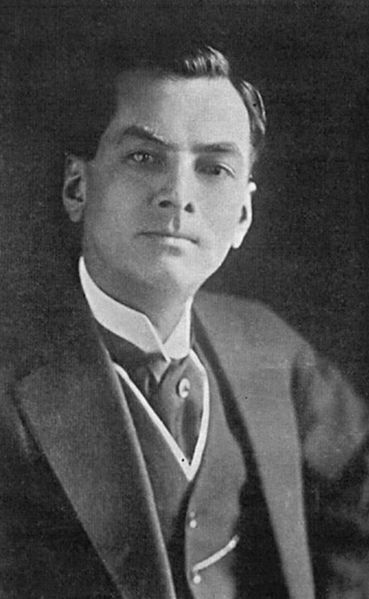<Back to Index>
- Inventors Orville and Wilbur Wright, 1871 and 1867
- Painter Gerbrand van den Eeckhout, 1621
- 2nd President of the Philippines Manuel Luis Quezon y Molina, 1878


Manuel Luis Quezon y Molina (August 19, 1878, in Baler, Tayabas, Philippines – August 1, 1944 in Saranac Lake, New York, United States) was the first Filipino president of the Commonwealth of the Philippines under U.S. colonial rule in the first half of the 20th century. He is considered by most Filipinos to have been the second President of the Philippines, after Emilio Aguinaldo. He has the distinction of being the first Senate President elected to the presidency, the first president elected through a national election, and the first incumbent to secure re-election (for a partial second term, later extended, due to amendments to the 1935 Constitution). He is known as the "Father of the National Language".
Quezon, was born in Baler, Tayabas (now Aurora). His Spanish mestizo parents were Lucio Quezon and María Dolores Molina. During the Philippine-American War he was an ayuda-de-campo to Emilio Aguinaldo. He rose to the rank of Major and fought in the Bataan sector
during the retreat and surrender in 1901. He received his primary
education from his mother and school teacher in their home town and
tutors (his father from Paco, Manila, was a Sergeant in the Spanish Army), and later boarded at the Colegio de San Juan de Letran where he completed secondary school. After the war, he completed Law at the University of Santo Tomas and
passed the bar examinations in 1903, placing fourth.
He worked for a time as a clerk and surveyor, entering government service as an appointed fiscal for Mindoro and later Tayabas. He became a councilor and was elected governor of Tayabas in 1906 as an independent. In 1907, he was elected to the first Philippine Assembly, where he served as majority floor leader and chairman of the committee on appropriations. From 1909–1916, he served as one of the Philippines' two resident commissioners to the U.S. House of Representatives, lobbying for the passage of the Philippine Autonomy Act or Jones Law.
He
was elected senator in 1916 and became Senate President, serving
continuously until 1935 (19 years). He headed the first Independent
Mission to the U.S. Congress in 1919 and securing passage of the Tydings-McDuffie Independence Law in 1934. In 1935 Quezon won the Philippine's first national presidential election under the banner of the Nacionalista Party. He obtained nearly 68% of the vote against his two main rivals, Emilio Aguinaldo and Gregorio Aglipay. Quezon was inaugurated in November 1935. He is recognized as the second President of the Philippines. However, in January 2008, House Representative Rodolfo Valencia of Oriental Mindoro filed a bill seeking instead to declare General Miguel Malvar as the second Philippine President, having directly succeeded Aguinaldo in 1901. President Quezon was given the power under the reorganization act, to appoint the first all-Filipino Supreme Court of the Philippines in
1935. From 1901 to 1935, although a Filipino was always appointed chief
justice, the majority of the members of the Supreme Court were
Americans. Complete Filipinization was achieved only with the
establishment of the Commonwealth of the Philippines in 1935. Claro M.
Recto and José P. Laurel were among Quezon's first appointees to
replace the American justices. The membership in the Supreme Court
increased to 11: a chief justice and ten associate justices, who sat en
banc or in two divisions of five members each. President Quezon initiated Women's Suffrage in the Philippines during the Commonwealth Era.
As a result of the prolonged debate between the proponents of women's
suffrage and their opponents, the Constitution finally provided that
the issue be resolved by the women themselves in a plebiscite. If no
less than 300,000 of them were to affirmatively vote in favour of the
grant within two years would be deemed granted the country's women.
Complying with this mandate, the government ordered a plebiscite to be
held for the purpose on April 3, 1937. Following
a rather vigorous campaign, on the day of the plebiscite, the turn out
of women was impressive. The affirmative votes numbered 447,725, as
against 44,307 who opposed the grant. Another
constitutional provision to be implemented by President Quezon's
administration dealt with the question of the national language.
Following a year's study, the Institute of the National Language -
established on 1936 - recommended that Tagalog be
adopted as the basis for the national language. The proposal was well
received, considering that the Director - the first to be appointed -
at the time Jaime C. de Veyra, was an ethnic Visayan. On
December 1937, Quezon issued a proclamation approving the constitution
made by the Institute and declaring that the adoption of the national
language would take place two years hence. With the presidential
approval, the Institute of National Language started to work on a
grammar and dictionary of the language. Quezon
had originally been barred by the Philippine constitution from seeking
re-election. However, in 1940, constitutional amendments were ratified
allowing him to seek re-election for a fresh term ending in 1943. In the 1941 presidential elections, Quezon was re-elected over former Senator Juan Sumulong with nearly 82% of the vote. In a notable humanitarian act, Quezon, in cooperation with United States High Commissioner Paul V. McNutt, facilitated the entry into the Philippines of Jewish refugees fleeing fascist regimes in Europe. Quezon was also instrumental in promoting a project to resettle the refugees in Mindanao. After the Japanese invasion of the Philippines during World War II he evacuated to Corregidor, then the Visayas and
Mindanao, and upon the invitation of the US government, was further
evacuated to Australia and then to the United States, where he
established the Commonwealth government in exile with headquarters in Washington, D.C.. There, he served as a member of the Pacific War Council, signed the declaration of the United Nations against the Axis Powers, and wrote his autobiography (The Good Fight, 1946). The
outbreak of World War II and the Japanese invasion resulted in periodic
and drastic changes to the government structure. Executive Order 390,
December 22, 1941 abolished the Department of the Interior and
established a new line of succession. Executive Order 396, December 24,
1941 further reorganized and grouped the cabinet, with the functions of
Secretary of Justice assigned to the Chief Justice of the Philippines. Quezon suffered from tuberculosis and spent his last years in a "cure cottage" in Saranac Lake, New York, where he died on August 1, 1944. He was initially buried in Arlington National Cemetery. His body was later carried by the USS Princeton and re-interred in Manila at the Manila North Cemetery before being moved to Quezon City within the monument at the Quezon Memorial Circle. Quezon was married to his first cousin, Aurora Aragón Quezon,
and had four children: María Aurora "Baby" Quezon (1919–1949),
María Zeneida "Nini" Quezon-Avancena (born 1921), Luisa
Corazón Paz "Nenita" Quezon (1923–1923) and Manuel L. "Nonong"
Quezon, Jr. (1926–1998). His grandson, Manuel L. "Manolo" Quezon III (born 1970), a prominent writer and political pundit, was named after him.